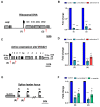Curvicollide D Isolated from the Fungus Amesia sp. Kills African Trypanosomes by Inhibiting Transcription
- PMID: 35682786
- PMCID: PMC9181715
- DOI: 10.3390/ijms23116107
Curvicollide D Isolated from the Fungus Amesia sp. Kills African Trypanosomes by Inhibiting Transcription
Abstract
Sleeping sickness or African trypanosomiasis is a serious health concern with an added socio-economic impact in sub-Saharan Africa due to direct infection in both humans and their domestic livestock. There is no vaccine available against African trypanosomes and its treatment relies only on chemotherapy. Although the current drugs are effective, most of them are far from the modern concept of a drug in terms of toxicity, specificity and therapeutic regime. In a search for new molecules with trypanocidal activity, a high throughput screening of 2000 microbial extracts was performed. Fractionation of one of these extracts, belonging to a culture of the fungus Amesia sp., yielded a new member of the curvicollide family that has been designated as curvicollide D. The new compound showed an inhibitory concentration 50 (IC50) 16-fold lower in Trypanosoma brucei than in human cells. Moreover, it induced cell cycle arrest and disruption of the nucleolar structure. Finally, we showed that curvicollide D binds to DNA and inhibits transcription in African trypanosomes, resulting in cell death. These results constitute the first report on the activity and mode of action of a member of the curvicollide family in T. brucei.
Keywords: African trypanosomiasis; curvicollide D; natural products; new trypanocidal molecule.
Conflict of interest statement
The authors declare no conflict of interest.
Figures







Similar articles
-
Computer-aided discovery of Trypanosoma brucei RNA-editing terminal uridylyl transferase 2 inhibitors.Chem Biol Drug Des. 2014 Aug;84(2):131-9. doi: 10.1111/cbdd.12302. Epub 2014 Jun 5. Chem Biol Drug Des. 2014. PMID: 24903413 Free PMC article.
-
Drug resistance in Trypanosoma brucei spp., the causative agents of sleeping sickness in man and nagana in cattle.Microbes Infect. 2001 Jul;3(9):763-70. doi: 10.1016/s1286-4579(01)01432-0. Microbes Infect. 2001. PMID: 11489425 Review.
-
Trypanocidal Activity of Flavokawin B, a Component of Polygonum ferrugineum Wedd.Planta Med. 2017 Feb;83(3-04):239-244. doi: 10.1055/s-0042-112031. Epub 2016 Jul 21. Planta Med. 2017. PMID: 27442262
-
Sleeping sickness pathogen (Trypanosoma brucei) and natural products: therapeutic targets and screening systems.Planta Med. 2011 Apr;77(6):586-97. doi: 10.1055/s-0030-1250411. Epub 2010 Oct 13. Planta Med. 2011. PMID: 20945274 Review.
-
Hit-to-lead development of the chamigrane endoperoxide merulin A for the treatment of African sleeping sickness.PLoS One. 2012;7(9):e46172. doi: 10.1371/journal.pone.0046172. Epub 2012 Sep 27. PLoS One. 2012. PMID: 23029428 Free PMC article.
Cited by
-
Photoredox-catalyzed regioselective allene alkoxycarbonylations for the synthesis of α-allyl-γ-lactones.Chem Sci. 2025 Jun 24;16(30):13816-13825. doi: 10.1039/d5sc02854j. eCollection 2025 Jul 30. Chem Sci. 2025. PMID: 40611989 Free PMC article.
References
-
- [(accessed on 25 April 2022)]. Available online: https://www.who.int/news-room/fact-sheets/detail/trypanosomiasis-human-a...

